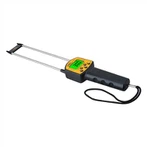How to Find the Fault of Electrical Control Circuit with Multimeter
There are many ways for the multimeter to measure whether the circuit is connected, and it is relatively simple. The following two methods are the most common for the multimeter to measure whether the circuit is connected. In order to explain more clearly and intuitively the multimeter measure the circuit.
If the on-off of the control loop in the above figure is measured, that is, the on-off of the circuit between line 1 and line 9:
First, the voltage measurement method.
First, power on the control circuit, and adjust the gear switch of the multimeter to the AC voltage range of 750V. According to the circuit schematic diagram, one test pen of the multimeter is kept on line 9, and the other test pen measures 8-7-6-5-4- Line 3, when the switch is not closed, the two test leads are in the same phase, and the voltage is 0V. When measuring line 2-1, the two test leads are out of phase, and the voltage is about 380V. This is the normal state of the circuit. , which line and which point's voltage value does not match the circuit schematic diagram, then in most cases, the point with the wrong voltage value is the fault point!
Second, the resistance measurement method.
First of all, it is necessary to cut off the power of the circuit, check the electricity, and after confirming that there is no electricity, adjust the gear switch of the multimeter to the buzzer or resistance gear, and place the two pens of the multimeter on line 1 and line 9 respectively: under normal circumstances, respectively Press the SB1 or SB2 button, or manually press the two AC contactor springs directly (that is, manually close the normally open point of KM1 or KM2), at this time 1-9 is turned on, the circuit is connected, and the multimeter will have Corresponding coil resistance. If there is no resistance value, it proves that the circuit is blocked. It is necessary to measure and analyze the on-off point by point according to the circuit schematic diagram. The measurement method is similar to the voltage.
Three, the resistance measurement method and the voltage measurement method of the multimeter are the two most used methods in circuit troubleshooting. It can be said that each has its own advantages and conveniences. The key is which one you use habitually. Use the method you are most familiar with with the help of a multimeter to measure.
How to Find the Fault of Electrical Control Circuit with Multimeter
There are generally voltage method and resistance method to find line faults. The voltage method is to use the voltage to detect the fault point, and the resistance method is to use the resistance to find the fault. They have their own advantages. If you are not familiar with the circuit, we recommend using the resistance method to judge the fault, which is relatively safe.
Before measuring the control wiring, disconnect the control wiring power supply/fuse to separate the control wiring from the main wiring. The purpose of this is to avoid interference from the main line when measuring the control line.
Then put one test lead on the odd starting number of the control loop (such as 101), and the other test lead on the even starting number of the control loop (such as 102), and the resistance between them should be infinite. Then press the button switch SB2, then there should be a certain resistance (the resistance is equal to the coil resistance). If the resistance value is still infinite, it means that there is no communication between the two test leads, and a certain place is broken, then continue to search.
If you don't have time to press the button, we can use short wires or other metal objects to short-circuit the button, and then remove it after testing.
Then we push the button again and measure the resistance between the next terminal of the starting terminal (103) and the even starting number (102). If there is a certain resistance value, it means that there is an open circuit between 101 and 103. If the resistance value is still infinite, it means that there is still an open circuit somewhere between 103 and 102, then continue to search.
Because the numbering rule determines that the mantissa is an odd number and an even number are two different polarity lines, so we measure the terminals ending in odd numbers and the terminals ending in even numbers, and there is normally a certain resistance between them. (Of course, the premise is the same power circuit)










